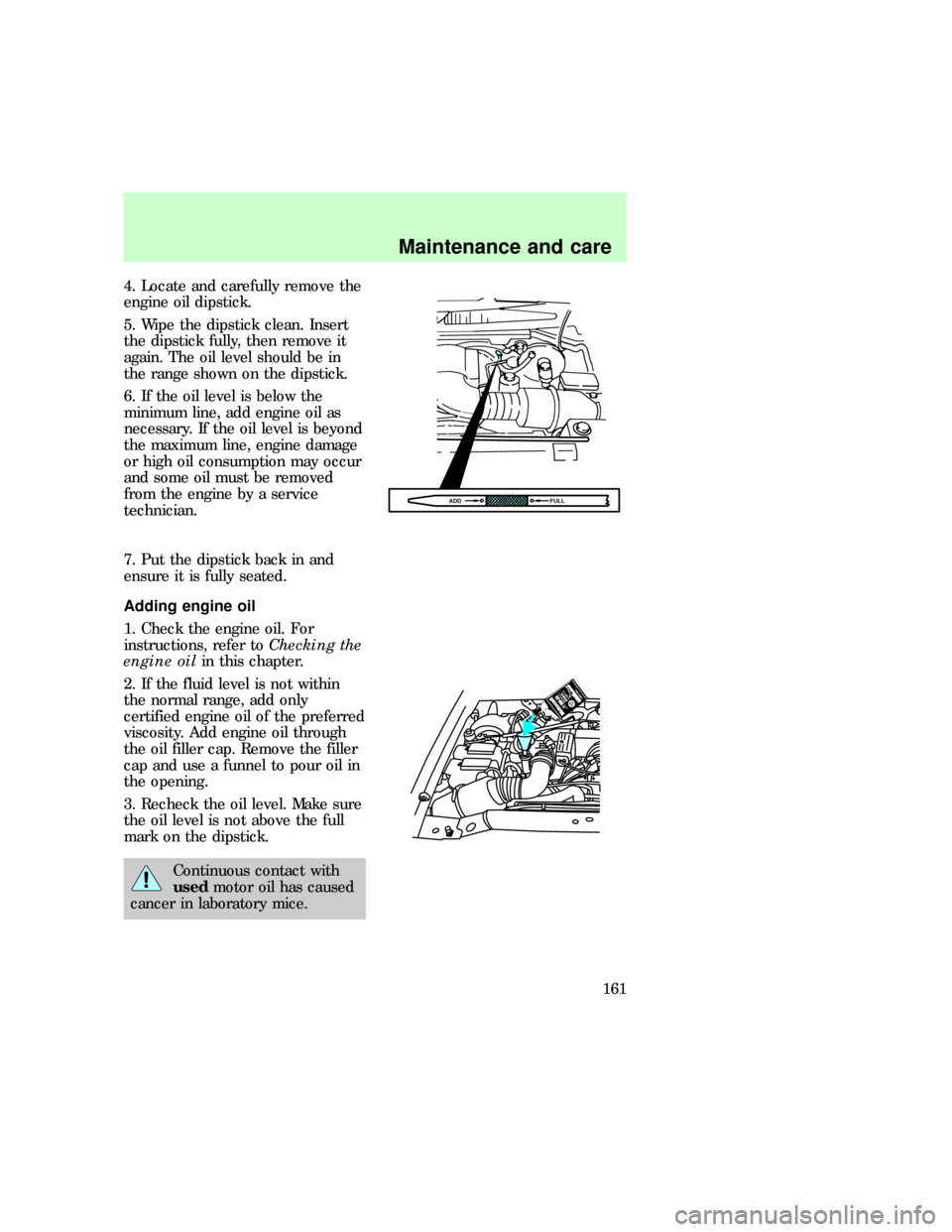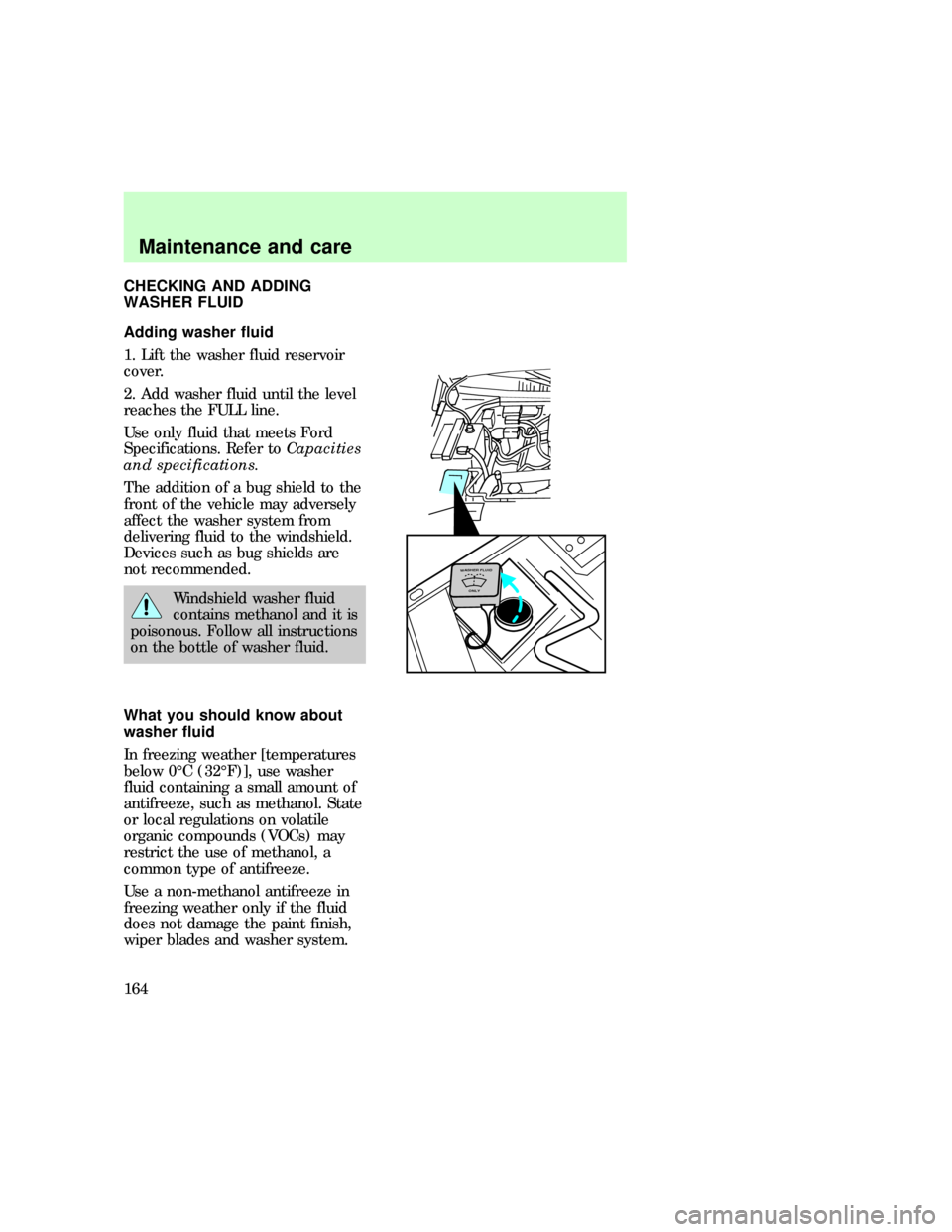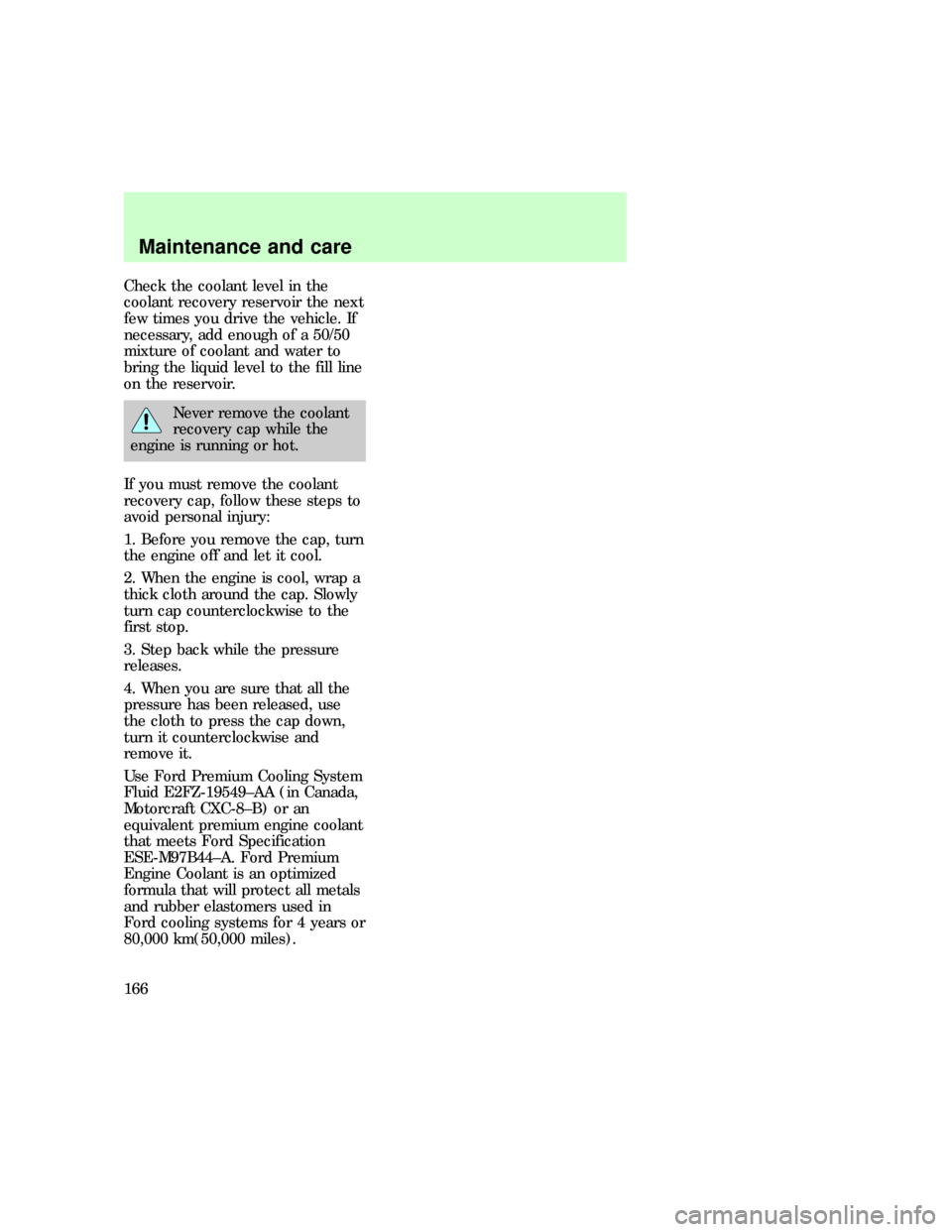Page 160 of 224

4. Locate and carefully remove the
engine oil dipstick.
5. Wipe the dipstick clean. Insert
the dipstick fully, then remove it
again. The oil level should be in
the range shown on the dipstick.
6. If the oil level is below the
minimum line, add engine oil as
necessary. If the oil level is beyond
the maximum line, engine damage
or high oil consumption may occur
and some oil must be removed
from the engine by a service
technician.
7. Put the dipstick back in and
ensure it is fully seated.
Adding engine oil
1. Check the engine oil. For
instructions, refer toChecking the
engine oilin this chapter.
2. If the fluid level is not within
the normal range, add only
certified engine oil of the preferred
viscosity. Add engine oil through
the oil filler cap. Remove the filler
cap and use a funnel to pour oil in
the opening.
3. Recheck the oil level. Make sure
the oil level is not above the full
mark on the dipstick.
Continuous contact with
usedmotor oil has caused
cancer in laboratory mice.
FULL ADD
com_adding_engine_oil.01
com_oil_and_filter_change.01
Maintenance and care
161
Page 161 of 224

Changing the engine oil and
filter
Change your engine oil and filter
according to the following
kilometers (mileage) and time
requirements, whichever occurs
first:
²Normal Schedule ± 8,000 km
(5,000 miles) or six months.
²Severe Duty Schedule ± 5,000
km (3,000 miles) or three
months. Severe duty operation
would include extensive idling,
trailer towing, driving in severe
dust and police, taxi or delivery
service.
Ford production and aftermarket
(Motorcraft) oil filters are designed
for added engine protection and
long life. If a replacement oil filter
is used that does not meet Ford
material and design specifications,
startup engine noises or knock
may be experienced.
It is recommended you use the
appropriate Motorcraft oil filter (or
another brand meeting Ford
specifications) for your engine
application.
Checking and adding brake
fluid
Brake fluid should be checked and
refilled as needed at least once
each year:
exd_fix-me
com_checking-adding_fluid.01
Maintenance and care
162
Page 162 of 224
²Clean the reservoir cap before
removal to prevent dirt or water
from entering the reservoir.
²Visually inspect the fluid level.
²If necessary, add brake fluid
until the level reaches MAX. Do
not fill above this line.
²Use only a DOT 3 brake fluid
certified to meet Ford
specifications. Refer to
Lubricant specificationsin the
Capacities and specifications
chapter.
Brake fluid is toxic.
If you use a brake fluid
that is not DOT 3, you will
cause permanent damage to your
brakes.
Do not let the reservoir for
the master cylinder run
dry. This may cause the brakes
to fail.
MAX
MIN
exd_washer-fluid
Maintenance and care
163
Page 163 of 224

CHECKING AND ADDING
WASHER FLUID
Adding washer fluid
1. Lift the washer fluid reservoir
cover.
2. Add washer fluid until the level
reaches the FULL line.
Use only fluid that meets Ford
Specifications. Refer toCapacities
and specifications.
The addition of a bug shield to the
front of the vehicle may adversely
affect the washer system from
delivering fluid to the windshield.
Devices such as bug shields are
not recommended.
Windshield washer fluid
contains methanol and it is
poisonous. Follow all instructions
on the bottle of washer fluid.
What you should know about
washer fluid
In freezing weather [temperatures
below 0ÉC (32ÉF)], use washer
fluid containing a small amount of
antifreeze, such as methanol. State
or local regulations on volatile
organic compounds (VOCs) may
restrict the use of methanol, a
common type of antifreeze.
Use a non-methanol antifreeze in
freezing weather only if the fluid
does not damage the paint finish,
wiper blades and washer system.
WASHER FLUID
ONLY
exd_adding_washer
exd_washer_fluid_info
exd_liftgate_washer_fluid
Maintenance and care
164
Page 164 of 224
Washer fluid in the liftgate
reservoir
Washer fluid for liftgate wiper and
washer operation is supplied by
the washer fluid reservoir located
in the engine compartment. For
information on adding fluid to this
main reservoir, refer toWasher
fluid in the windshield reservoir
in this chapter.
CHECKING AND ADDING
ENGINE COOLANT
Adding engine coolant
Do not put engine coolant
in the container for the
windshield washer fluid.
If sprayed on the windshield,
engine coolant could make it
difficult to see through the
windshield.
When the engine is cool, add a
50/50 mixture of engine coolant
and water to the engine coolant
recovery reservoir Ð DO NOT
ADD DIRECTLY TO THE
RADIATOR. Add straight water
only in an emergency, but you
should replace it with a 50/50
mixture of coolant and distilled
water as soon as possible.
COOLANT FILL
LEVEL
exd_coolant
exd_adding_coolant
Maintenance and care
165
Page 165 of 224

Check the coolant level in the
coolant recovery reservoir the next
few times you drive the vehicle. If
necessary, add enough of a 50/50
mixture of coolant and water to
bring the liquid level to the fill line
on the reservoir.
Never remove the coolant
recovery cap while the
engine is running or hot.
If you must remove the coolant
recovery cap, follow these steps to
avoid personal injury:
1. Before you remove the cap, turn
the engine off and let it cool.
2. When the engine is cool, wrap a
thick cloth around the cap. Slowly
turn cap counterclockwise to the
first stop.
3. Step back while the pressure
releases.
4. When you are sure that all the
pressure has been released, use
the cloth to press the cap down,
turn it counterclockwise and
remove it.
Use Ford Premium Cooling System
Fluid E2FZ-19549±AA (in Canada,
Motorcraft CXC-8±B) or an
equivalent premium engine coolant
that meets Ford Specification
ESE-M97B44±A. Ford Premium
Engine Coolant is an optimized
formula that will protect all metals
and rubber elastomers used in
Ford cooling systems for 4 years or
80,000 km(50,000 miles).
Maintenance and care
166
Page 166 of 224

Do not use alcohol or methanol
antifreeze or any engine coolants
mixed with alcohol or methanol
antifreeze. Do not use
supplemental coolant additives in
your vehicle. These additives may
harm your engine cooling system.
The use of an improper coolant
may void the warranty of your
vehicle's engine cooling system.
Recycled engine coolant
Ford Motor Company recommends
that Ford and Lincoln-Mercury
dealers use recycled engine coolant
produced by Ford-approved
processes. Not all coolant recycling
processes produce coolant which
meets Ford specification
ESE-M97B44±A, and use of such
coolant may harm engine and
cooling system components.
Always dispose of used
automotive fluids in a responsible
manner. Follow your community's
regulations and standards for
recycling and disposing of
automotive fluids.
Coolant refill capacity
To find out how much fluid your
vehicle's cooling system can hold,
refer toRefill capacitiesin the
Capacities and specifications
chapter.
Have your dealer check the engine
cooling system for leaks if you have
to add more than a liter (quart) of
engine coolant per month.
exd_recycled_coolant
exd_refill_capacity
exd_winter_climate
Maintenance and care
167
Page 167 of 224
Severe winter climate
If you drive in extremely cold
climates [less than 36ÉC (34ÉF)], it
may be necessary to increase the
coolant concentration above 50%.
Refer to the chart on the coolant
container to ensure the coolant
concentration in your vehicle is such
that the coolant will not freeze at
the temperature level in which you
drive during winter months. Never
increase the engine coolant
concentration above 60%. Leave a
50/50 mixture of engine coolant and
water in your vehicle year-round in
non-extreme climates.
Checking the cooling system
hoses
Inspect all engine and heater system
hoses and hose connections for:
com_checking_hoses.01
Maintenance and care
168